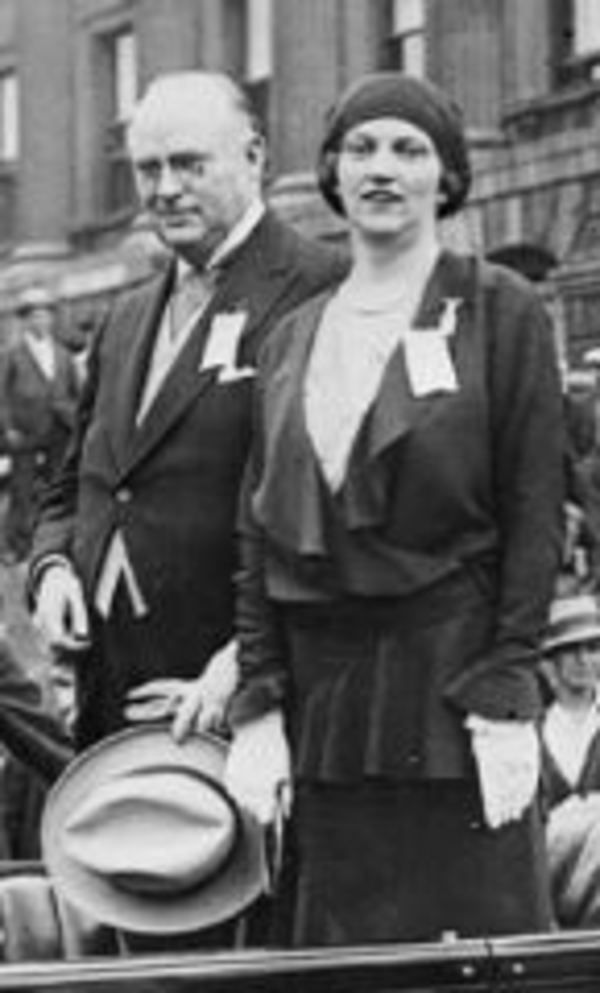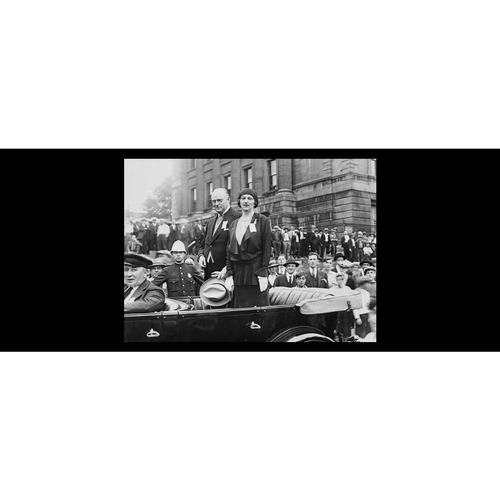
Source: Link
BENNETT, MILDRED MARIANN (Herridge), political assistant and hostess; b. 26 March 1889 in Hopewell Cape, N.B., youngest child of Henry John Bennett and Henrietta Stiles; m. 14 April 1931 William Duncan Herridge* in Ottawa, and they had one son; d. 12 May 1938 in New York City and was buried six days later in Vancouver.
Mildred Mariann Bennett was a surprise to her parents: her mother was in her mid forties when Mildred was born, and the next youngest of her four living children (a son had died in 1876) was eight years old. Wooden shipbuilding, the family business for most of a century, had hit hard times by the late 19th century, but the eldest son, Richard Bedford Bennett*, had done very well for himself since going west to Calgary in 1897 to work at the law firm of James Alexander Lougheed*. When his father died in 1905, Dick, as he was called, became head of the family, and it was almost certainly he who paid for Mildred’s attendance at the Mount Allison ladies’ college in Sackville, N.B., which she entered that year. Mildred grew up to be an intelligent, outgoing, gracious, and self-confident young woman, in no small measure thanks to her brother Dick.
Travel became an informal but certainly influential part of Mildred’s education during her teenage years, when Dick started inviting her to accompany him on his trips to Britain and continental Europe. Despite an age difference of almost 19 years (which may have contributed to gossipy rumours that she was the daughter of Bennett and Jennie Grahl Hunter Eddy [Shirreff*]), the siblings bonded in an unusually affectionate, although always totally proper, relationship. Mildred delighted in helping him buy clothes in London’s fashionable districts, while he ensured that she met people, saw places, and had experiences that few of her Canadian contemporaries ever would. They were good for one another, even though on occasion he would reprimand her for enjoying a glass of champagne or running up a shopping bill on his tab. But he could never stay angry with Mildred for long. She knew how to soothe his quick temper and frequently guided him away from bellicose confrontations with those whose support he would need.
Upon completion of her ba in 1911 Mildred returned to Hopewell Cape to live with her mother and her sister, Evelyn Read, a schoolteacher. Soon after Henrietta’s death in 1914, Evelyn married Horace Weldon Coates, a doctor, and they settled in Vancouver, where he had procured a position. Dick, whose twin careers in business and law were thriving, bought the newlyweds a house, and Mildred moved to British Columbia to live with them. She was a support to Evelyn, whose husband served as a medical officer during the war, and she often visited her big brother in Calgary, where he rented an extra room for her use adjoining his suite at the Palliser Hotel.
In 1927 the Conservative Party of Canada planned its first-ever leadership convention in Winnipeg to choose a successor to Arthur Meighen*, who had resigned following the election defeat in 1926. Meighen’s interim replacement, Hugh Guthrie, would eventually resolve to seek the permanent post. Mildred became involved, initially by helping the chief organizer, Major-General Alexander Duncan McRae*. Then her brother decided to throw his hat in the ring, and on 13 October he was chosen as the new head of the party. A significant part of that victory was thanks to Mildred: she had served as his informal emissary to the women delegates, who made up about 15 per cent of the total. Once he became the Conservative Party chieftain, Mildred seemed to find her calling. She promised to stay and work with him until he was elected prime minister. Everywhere he campaigned over the next three years, she was beside him.
R. B. and Mildred Bennett made a formidable team. He was a compelling platform speaker but was noticeably lacking in the social graces. She more than compensated for this deficiency. Unlike her brother, she exuded charm and joie de vivre. Veteran party organizer and newspaperman Arthur Rutherford Ford* would note in his memoir, As the world wags on (Toronto, 1950), that “she had all the tact and diplomacy, graciousness and ability to meet the public which Mr. Bennett often lacked.” Strategists wisely took advantage of her charismatic appeal among Canadians, particularly women voters. “I think they would like to see your smile,” McRae had candidly advised her at the start of the 1930 federal campaign tour. Employing new technology, the party featured her on a promotional gramophone record intended for use at “afternoon tea parties and other functions carried on by the ladies.” When on 28 July the Conservatives captured a solid majority, it was to a considerable degree due to the contributions of Mildred Bennett.
R. B. Bennett was sworn in as prime minister on 7 August, and Mildred appeared beside him in the official press photograph. She moved into a suite adjacent to his in the Château Laurier hotel. When he sailed to London in October to attend the Imperial Conference, she went along as a significant member of his entourage. But her role as his informal “first lady” was about to change. On the campaign trail a romance had blossomed between Mildred and Major William Duncan Herridge, a war hero and prominent Ottawa lawyer. A former Liberal, he had broken with that party’s leader, William Lyon Mackenzie King*, in 1926, at the time of the King–Byng controversy [see Julian Hedworth George Byng], and had subsequently joined the Conservative team as a speech writer and adviser. It was he who coined some of Bennett’s most memorable campaign rhetoric, designed to address the impact of what would become known as the Great Depression, including the pledge to “blast a way” into world markets and the promise to end unemployment or “perish in the attempt.”
As a young woman, Mildred had vowed to her brother that she would not marry before he did, but now in her forties she had changed her mind. The prime minister announced the couple’s engagement on 2 April 1931. The Herridge–Bennett wedding, which took place at Chalmers United Church 12 days later, was one of the highlights of the Ottawa social calendar. The Globe (15 April 1931) reported that the prime minister had “appeared deeply moved as he prepared to give in marriage his beloved sister, who has been an almost inseparable companion for many years.” After a European honeymoon, the couple moved to Washington, where William Herridge succeeded Charles Vincent Massey* as Canadian envoy extraordinary and minister plenipotentiary to the United States. The appointment had been announced in the month before the nuptials. Cynics derided it as little more than Bennett’s wedding gift, and some partisan mps accused Bennett of using government funds to finance the honeymoon. Herridge would, however, prove to be an energetic and capable ambassador. Mildred Herridge’s talents as a convivial hostess were put to good use in the American capital, although she continued to serve as her brother’s companion at major social and ceremonial occasions in Ottawa, including the Imperial Economic Conference in July 1932. Her appearance alongside the prime minister that summer was all the more remarkable because she had borne a son only two months earlier, at the age of 43.
Mildred Herridge occasionally found herself torn between the two men in her life. At the time of her marriage, she had confessed in a brief note addressed to “Dick, my dear dear brother” her mixed emotions: “I sometimes think that loving Bill as I do – I’ve loved and valued you even more.” Her overlapping allegiances became increasingly stressful in 1935 when her husband and brother quarrelled about strategy in the lead-up to the federal election and the prime minister banished his brother-in-law from his inner circle of advisers. With the decisive defeat of the Conservative government in October 1935, Bennett returned to the opposition benches and the Herridges moved back to Ottawa. Mildred accompanied her brother to England in 1937 for the coronation of George VI, but this would be their last trip together – she had been diagnosed with cancer. After the ceremony they checked in to a spa in Germany; his doctor had recommended rest for his heart condition. She later sought treatment at a hospital in New York City. The following spring, not long after Bennett announced his resignation, her health worsened and she returned to hospital. The measure of her deep affection for him is evident in a letter she sent after he visited her: “How wonderful it was of you to come and see me yesterday, and how much good it did me to see my dear old brother who has always gone ahead of me in life and scattered roses in my path.” Five weeks later she succumbed, leaving a major gap in the lives of her husband, young son, and brother. According to her wishes, after the funeral in Ottawa she was interred alongside her sister in Mountain View Cemetery, Vancouver.
Mildred Herridge’s life symbolized in some respects the changing expectations about women’s roles in the early 20th century. Although well educated, she did not pursue a career as such. Yet there were few men who could work a crowd as well as she did, a talent that helped her brother to become prime minister and her husband to succeed as a diplomat. She demonstrated the capacity and potential of women to move out of the private sphere into public life. Though she was only 49 when she died, she had assuredly made a difference in national politics. Other women would follow in her footsteps.
Globe and Mail, 13, 16 May 1938. Ottawa Citizen, 2 April 1931. Ottawa Evening Journal, 14 April 1931. L. A. Glassford, Reaction and reform: the politics of the Conservative Party under R. B. Bennett, 1927–1938 (Toronto, 1992). J. H. Gray, R. B. Bennett: the Calgary years (Toronto, 1991). P. B. Waite, In search of R. B. Bennett (Montreal and Kingston, Ont., 2012); The loner: three sketches of the personal life and ideas of R. B. Bennett, 1870–1947 (Toronto, 1992).
Cite This Article
Larry A. Glassford, “BENNETT, MILDRED MARIANN (Herridge),” in Dictionary of Canadian Biography, vol. 16, University of Toronto/Université Laval, 2003–, accessed December 28, 2025, https://www.biographi.ca/en/bio/bennett_mildred_mariann_16E.html.
The citation above shows the format for footnotes and endnotes according to the Chicago manual of style (16th edition). Information to be used in other citation formats:
| Permalink: | https://www.biographi.ca/en/bio/bennett_mildred_mariann_16E.html |
| Author of Article: | Larry A. Glassford |
| Title of Article: | BENNETT, MILDRED MARIANN (Herridge) |
| Publication Name: | Dictionary of Canadian Biography, vol. 16 |
| Publisher: | University of Toronto/Université Laval |
| Year of publication: | 2023 |
| Year of revision: | 2023 |
| Access Date: | December 28, 2025 |




